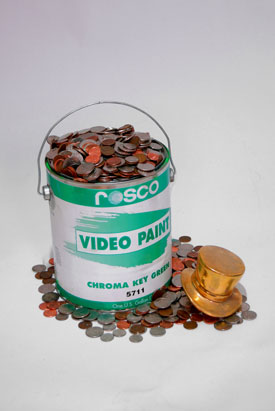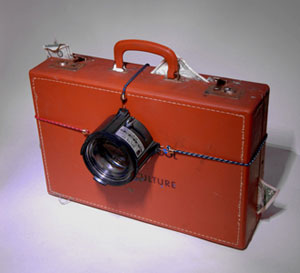The new film coast?

| By Matt LevinePhotos by Jeff Kenney |
With local film icons as disparate as experimental luminary James Benning and the ubiquitous Mark Borchardt, Milwaukee’s cinematic offerings have always been eclectic and fruitful. But in the last several years, our film scene has seen rapid development — the onset, perhaps, of a new period of national exposure to compare favorably with that of New York or Los Angeles.
Sound unlikely? Maybe not after the recent initiation of Senate Bill #563: the Film Wisconsin bill. Signed into law in May of 2006, the bill went into effect on January 1 of this year, granting Wisconsin some of the nation’s most film-friendly tax incentives. Filmmakers may claim an investment tax credit of 25% for Wisconsin-based productions, as well as a 0% tax for all film and television services contracted by out-of-state production companies, a 15% state income tax credit for media businesses that make a capital investment in Wisconsin, and other magnanimous boons.
The bill is unofficially named after the non-profit organization that helped usher in its existence — Film Wisconsin, whose efforts are dedicated to sustaining Wisconsin’s film and media industry. Film Wisconsin was created to fill the void left by the Wisconsin Film Office, which, due to budget cuts, was forced to close in July 2005 after 18 years of service. In April of the same year, aware of the Wisconsin Film Office’s impending closure, a task force of filmmakers set out to create Film Wisconsin, touring the state and working closely with its production community. A grassroots effort began to grant competitive statewide tax incentives, an effort that gained surprising speed as its economic payoff became apparent to state legislators.
“You’ll see an increase in the number of independent films made in Wisconsin and in the number of commercial films that come here,” says Scott Robbe, head of Film Wisconsin, which is based in downtown Milwaukee in office space shared with Visit Milwaukee and the Milwaukee Cultural Alliance. “The logistics of making movies will be much easier, and you’ll have a much greater synergy with Chicago’s film scene.” Indeed, Robbe speaks with enthusiasm of a partnership with Chain Reaction Studios in Milwaukee and Fletcher Camera in Chicago, the “Midwest contingent” that recently spread the word at the Sundance Film Festival about Wisconsin’s plentiful filmmaking incentives.
CLASH OF THE INDIE TITANS
The benefits the bill brings to Wisconsin cannot be overstated. There are tangible gains: the direct and indirect sources of revenue, the jobs a new industry will create both on and off sets and soundstages, the profits for the video game manufacturing industry (which receives tax incentives equal to film or television) and the new film-related businesses a healthy film economy would support. But perhaps as significantly, there’s an invigorating sense of expectation, an electrifying atmosphere of impending action. How the vast scope of possibility will manifest is, of course, still unknown, but a look at the present film scene may offer a glimpse at its future.
 The demarcation between independent, mainstream and experimental films is usually hazy and arbitrary, peddled to us by marketers in the film industry, but the terms are useful at least in charting moviegoing and filmmaking trends. Trying to sort out a city’s film or arts scene is nearly impossible; an artistic community is by nature amorphous, made up of eclectic sensibilities. Yet any cinephile living in Milwaukee over the last 10 years has witnessed a film community in undeniable transformation.
The demarcation between independent, mainstream and experimental films is usually hazy and arbitrary, peddled to us by marketers in the film industry, but the terms are useful at least in charting moviegoing and filmmaking trends. Trying to sort out a city’s film or arts scene is nearly impossible; an artistic community is by nature amorphous, made up of eclectic sensibilities. Yet any cinephile living in Milwaukee over the last 10 years has witnessed a film community in undeniable transformation.
The University of Wisconsin-Milwaukee’s film department, which has a reputation for leaning towards the experimental, has provided Milwaukee with a varied and unpredictable selection of films through its programming of national avant-garde cinema as well as its own student filmmaking. Woodland Pattern Book Center’s film screenings rival UWM’s programming in terms of originality and breadth, which is hardly a surprise – the Riverwest establishment’s film screenings are programmed by Carl Bogner, who also works in the university’s film department and is responsible for bringing many of the best films to our city each year. For a time, the Times Cinema also presented some of the rarest and best in modern and classic world cinema (I have fond memories of taking the hour-long bus ride across Milwaukee to see something like Into Great Silence), but since they started showing Sweet Land every other week and projecting classics on dvd instead of 35mm, the options for seeing avant-garde or “art house” cinema (whatever that means) are now basically limited to UWM, occasionally the Landmark’s Oriental or Downer Theatre, or basement screenings primarily intended for friends and family.
Does this suggest that Milwaukee’s film community is sliding from the experimental realm into the more general independent designation or even (gasp!) the mainstream?
Bobby Ciraldo of Special Entertainment thinks so. “Four years ago, people were focusing more on experimental films and things like that, but now they’re becoming a little more accessible,” he says. “I think when I [moved to Milwaukee] there was a strong push to make something that only a small group of people would watch and like. It was so experimental and really cool.”
What Ciraldo may have noticed is a marked increase in the number of local low-budget, independent narrative features floating around Milwaukee — one-night only screenings at area movie theatres, showings at area film festivals, or artists trying to peddle their wares over the Internet. Five years ago — when I first attended UW-Milwaukee’s Film Production program — the emphasis on the avant-garde was still largely in place, and many local independent endeavors were of the experimental variety. Whenever a one-shot film screening took place at a bar or in someone’s basement, it often consisted of an inscrutable narrative, fly-on-the-wall 16mm aesthetic, formal play with light and movement, or other experimental motifs. Stonefly — back when it was still Onopa Brewing Company — showed a series of experimental films abstractly dealing with America’s current political climate (as the 2004 campaigns had just begun, it was an unsurprisingly heated program), a radical event that would have little chance of recurring today, at least at the same venue.
The last five years have treated us to local indie pictures like the Oriental-screened The Thickness of Delirium, the cgi-laden features of Lightning Rod Studios (Carnivorous, Guardians, The Sleeper), the Delafield-shot Red Betsy (which was screened in select Marcus Theatres), Milwaukee International Film Festival favorites Chump Change, Milwaukee, Minnesota and The Godfather of Green Bay, and an influx of submissions to MIFF and other local festivals embracing a similar independent aesthetic. In UW-Milwaukee’s film department, in more student films embrace narratives instead of avant-garde techniques, or (perhaps more audaciously) attempt a fusion of the two. The Student Film Festival, which takes place every semester and provides undeniable proof that UWM offers some of the most invigorating filmmaking anywhere in the city, today showcases a balanced lineup of narrative, experimental and documentary works.
Is it necessarily a bad thing if Milwaukee is indeed undergoing a push towards narrative (read: marketable) cinema? Drew Maxwell, founder of Lightning Rod Studios, thinks not. A production and visual effects company that works closely with reps and studios in Los Angeles, Maxwell and business partner Dan Kattman know the world of film marketing intimately.
“The [film] atmosphere here in Milwaukee has been changing more to commercial films, less on small artsy films that are almost like student films,” says Maxwell. “I still have concerns about the marketability of those [art] films. But the production value is getting bigger in movies that are made here, and that’s what distributors want. They won’t even talk to you unless you have [quality production values] in your film.” He shows me a scene from an upcoming release in post-production; it couldn’t be further from the underground films I’m usually a sucker for, but its immersive visual world and its abstractly beautiful cgi backgrounds are astounding.
Robyn Braun, co-director of the Milwaukee Underground Film Festival, says no. “The fact of the matter is that narrative sells, and independent narrative is very popular these days,” she says. “The best-known movie to come out of Milwaukee and from a UWM student is American Movie. There was nothing experimental about it. I would say that there is more tension surrounding the subject [of narrative versus experimental filmmaking] in UWM’s film department itself than in the actual community. I feel that the filmmaking community of Milwaukee is very supportive of its members creatively. I do not think this will change even if its genre does.”
Indeed, discussions with many local filmmakers and programmers convey a similarly reassuring optimism. Andrew Swant – Bobby Ciraldo’s partner and co-creator at Special Entertainment – says Milwaukee’s filmmaking scene is “a close community. Everybody has their own projects, but everybody’s willing to help each other out.”
“It’s weirdly communal,” agrees Ciraldo. “There’s a hippie vibe to it.”
Ross Bigley, director of the Milwaukee Short Film Festival, sees it differently. “The local filmmaking community is an isolated bunch. I’ve seen it getting better with each year that our festival has gone on, but we still have room for improvement. We are acknowledging one another now, but working together and giving this city another voice is only a few short steps away.”
FESTIVAL CITY
One of those imperative steps, it seems, is greater communication between area exhibitors and the filmmakers themselves. One part of the film industry cannot exist without the other — a masterpiece that’s never shown to an audience has little contribution to make to society; a movie theatre, film festival or rental house does not have a place in its community if it does not embrace and promote the art made within that community.
 The regional film festival epitomizes the rapport between filmmakers and exhibitors. Most cities lack a distribution company with the ability to spread local filmmaking throughout the country or an exhibitor with the funds to regularly screen homegrown movies — which, of course, leaves the anticipatory atmosphere (what masterpiece will be discovered next?) and wider exposure of the film fest.
The regional film festival epitomizes the rapport between filmmakers and exhibitors. Most cities lack a distribution company with the ability to spread local filmmaking throughout the country or an exhibitor with the funds to regularly screen homegrown movies — which, of course, leaves the anticipatory atmosphere (what masterpiece will be discovered next?) and wider exposure of the film fest.
It’s difficult today to find a city that doesn’t have a proliferation of do-it-yourself festivals, but even in this Milwaukee excels. With the Milwaukee LGBT Film Festival, Underground Film Festival, Short Film Festival, 48-Hour Film Project, UWM’s Student Film Festival and too many others to mention (see our story on page 14 about this month’s Women Without Borders film festival), there are nearly year-round opportunities to attend and participate. Around the region but still close to home are the excellent Wisconsin Film Festival in Madison, Beloit’s International Film Festival, Blackpoint in Lake Geneva, Wildwood in the Fox Valley and a host of others. Then of course there’s the venerable Milwaukee International Film Festival, now in its sixth year and an anticipated cultural event. As MIFF has grown, its programming has evolved to include an expanded slate of workshops and events, creating even greater opportunities for both filmmakers and film devotees.
VIRTUAL HORIZONS
Arguably, independent filmmakers now have more possibilities to distribute and exhibit their work than ever before. The number of artists and short films made famous (or infamous) through YouTube and personal websites has already established the Internet as the next great step in the film industry’s evolution, even if many mainstream studios and distribution companies have yet to take advantage of this capability.
Milwaukee’s best example of overnight Internet success may be Swant and Ciraldo, whom you might know from their video for Samwell’s ‘What What In the Butt.’ For months they remained the anonymous creators of a million-hit world-famous video, overhearing random conversations about it while hiding behind the proverbial curtain. This is something that never could have happened before the digital age — a self-distributed video becoming widely, but anonymously, famous.
“That’s totally new, as of the 2000s,” says Ciraldo. “Being able to promote this thing without ever knowing who did it or why.”
The Internet has one drastic and obvious shortcoming: that pixilated box sitting on your desk (no matter how high the definition or how flat the screen) doesn’t compare to a darkened movie theatre, cinema’s natural habitat. For more than a century, film has been essentially an art of light: chemicals responding to light on celluloid, film images projected through a light beam flickering 24 times per second. The digital age offers a seemingly infinite number of possibilities, but it carries some drawbacks that negatively alter the way we experience movies.
“As a filmmaker, the technology of the Internet is not where it needs to be yet in regard to video,” says local filmmaker Tate Bunker. “It’s horrible to think someone is watching my film on a pixelated 5” x 5” Internet box or on an iPhone; it’s just not the same as a movie theater. It’s not even close.”
While I’d sooner watch Meet the Spartans in a movie theatre than any full-length movie on the Internet, one can’t deny the digital age has changed moviemaking (and movie watching). Add to these capabilities the remarkably strong festival circuit already established in Milwaukee and the passing of the Film Wisconsin bill and you have a cinematic atmosphere ripe with possibility. While it’s unlikely that New York and Los Angeles will ever lose their positions as America’s foremost film capitals, Wisconsin may earn its hoped-for due as “the new affordable, film-friendly third coast.”
With projects already underway in our state — including an already-filmed NBC pilot that may air in 2008, a new show for the Travel Channel, independent features including The Violinist, Blue World, and Feed the Fish starring Tony Shalhoub, a new film from Carlo Besasie and Mike Gillis (makers of The Cherry Tree) and many more sure to come thanks to the incredibly inexpensive location shooting offered by Film Wisconsin’s tax incentives — such great expectations for the future of our state’s cinema don’t seem impractical. And while none of this guarantees Milwaukee validation for its own filmmaking scene, so many lenses suddenly turned on our state undeniably creates the opportunity for the rest of the world to experience what Wisconsin cinema may be. VS
Visit our News page for more information about the Film Wisconsin bill and new initiatives to improve its benefits.
Movies
-
Milwaukee Film Festival Returns in April
 Mar 27th, 2024 by Sophie Bolich
Mar 27th, 2024 by Sophie Bolich
-
Nina Simone’s Summer of Soul
 Nov 29th, 2022 by John Sieger
Nov 29th, 2022 by John Sieger
-
The Surprise Pick for Best Picture
 Mar 22nd, 2022 by Dominique Paul Noth
Mar 22nd, 2022 by Dominique Paul Noth














Why is Drew Maxwell interviewed? The guy is a hack and his movies are utter trash. There is some real talent in Milwaukee. Drew Maxwell is not it.